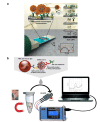Microfluidics-Based POCT for SARS-CoV-2 Diagnostics
- PMID: 36014162
- PMCID: PMC9413395
- DOI: 10.3390/mi13081238
Microfluidics-Based POCT for SARS-CoV-2 Diagnostics
Abstract
A microfluidic chip is a tiny reactor that can confine and flow a specific amount of fluid into channels of tens to thousands of microns as needed and can precisely control fluid flow, pressure, temperature, etc. Point-of-care testing (POCT) requires small equipment, has short testing cycles, and controls the process, allowing single or multiple laboratory facilities to simultaneously analyze biological samples and diagnose infectious diseases. In general, rapid detection and stage assessment of viral epidemics are essential to overcome pandemic situations and diagnose promptly. Therefore, combining microfluidic devices with POCT improves detection efficiency and convenience for viral disease SARS-CoV-2. At the same time, the POCT of microfluidic chips increases user accessibility, improves accuracy and sensitivity, shortens detection time, etc., which are beneficial in detecting SARS-CoV-2. This review shares recent advances in POCT-based testing for COVID-19 and how it is better suited to help diagnose in response to the ongoing pandemic.
Keywords: SARS-CoV-2; microfluidic; point of care testing.
Conflict of interest statement
The authors declare no conflict of interest.
Figures








Similar articles
-
Microfluidics-Based Point-of-Care Testing (POCT) Devices in Dealing with Waves of COVID-19 Pandemic: The Emerging Solution.ACS Appl Bio Mater. 2022 May 16;5(5):2046-2068. doi: 10.1021/acsabm.1c01320. Epub 2022 Apr 27. ACS Appl Bio Mater. 2022. PMID: 35473316 Review.
-
μPADs on Centrifugal Microfluidic Discs for Rapid Sample-to-Answer Salivary Diagnostics.ACS Sens. 2023 Sep 22;8(9):3520-3529. doi: 10.1021/acssensors.3c01093. Epub 2023 Sep 5. ACS Sens. 2023. PMID: 37669403
-
Microfluidic Point-of-Care Testing: Commercial Landscape and Future Directions.Front Bioeng Biotechnol. 2021 Jan 15;8:602659. doi: 10.3389/fbioe.2020.602659. eCollection 2020. Front Bioeng Biotechnol. 2021. PMID: 33520958 Free PMC article. Review.
-
[Isothermal amplification technology based on microfluidic chip].Sheng Wu Gong Cheng Xue Bao. 2022 Mar 25;38(3):943-960. doi: 10.13345/j.cjb.210533. Sheng Wu Gong Cheng Xue Bao. 2022. PMID: 35355466 Review. Chinese.
-
Antigen-Based Point of Care Testing (POCT) for Diagnosing SARS-CoV-2: Assessing Performance.Methods Mol Biol. 2022;2452:45-62. doi: 10.1007/978-1-0716-2111-0_4. Methods Mol Biol. 2022. PMID: 35554900
Cited by
-
Digital Microfluidic Multiplex RT-qPCR for SARS-CoV-2 Detection and Variants Discrimination.Micromachines (Basel). 2023 Aug 17;14(8):1627. doi: 10.3390/mi14081627. Micromachines (Basel). 2023. PMID: 37630161 Free PMC article.
-
Development of a time-resolved immunochromatographic test strip for rapid and quantitative determination of retinol-binding protein 4 in urine.Mikrochim Acta. 2024 May 8;191(6):311. doi: 10.1007/s00604-024-06381-6. Mikrochim Acta. 2024. PMID: 38717575
-
Advances in Research on Isothermal Signal Amplification Mediated MicroRNA Detection of Clinical Samples: Application to Disease Diagnosis.Biosensors (Basel). 2025 Jun 18;15(6):395. doi: 10.3390/bios15060395. Biosensors (Basel). 2025. PMID: 40558477 Free PMC article. Review.
-
Rapid detection of SARS-CoV-2 RNA using a one-step fast multiplex RT-PCR coupled to lateral flow immunoassay.BMC Infect Dis. 2024 Dec 18;24(1):1417. doi: 10.1186/s12879-024-10296-1. BMC Infect Dis. 2024. PMID: 39695471 Free PMC article.
-
Advancements in SARS-CoV-2 Testing: Enhancing Accessibility through Machine Learning-Enhanced Biosensors.Micromachines (Basel). 2023 Jul 28;14(8):1518. doi: 10.3390/mi14081518. Micromachines (Basel). 2023. PMID: 37630054 Free PMC article. Review.
References
-
- Jin Y.H., Cai L., Cheng Z.S., Cheng H., Deng T., Fan Y.P., Fang C., Huang D., Huang L.Q., Huang Q., et al. A rapid advice guideline for the diagnosis and treatment of 2019 novel coronavirus (2019-nCoV) infected pneumonia (standard version) Mil. Med. Res. 2020;7:4. doi: 10.1186/s40779-020-0233-6. - DOI - PMC - PubMed
Publication types
Grants and funding
- 52075138/National Natural Science Foundation of China
- BK20190872/Natural Science Foundation of Jiangsu Province
- CX(21)3162/Jiangsu Agricultural Science and Technology Innovation Fund
- KYCX22_3479/Postgraduate Research & Practice Innovation Program of Jiangsu Province
- 2021BSJJ001/Doctoral Scientific Research Foundation of Zhengzhou University of Light Industry
LinkOut - more resources
Full Text Sources
Miscellaneous

